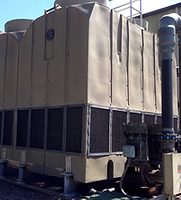Cooling tower replacement increases capacity at manufacturing plant

Cooling towers help reduce the heat of circulating water used to cool industrial processes and HVAC systems throughout the world. These towers have undergone substantial design changes over the years. One change that has been particularly noticeable is the introduction of high-density polyethylene (HDPE) cooling towers.
The HDPE cooling towers have gained a reputation for providing long service life and reducing maintenance requirements. While these attributes are compelling, the idea of incorporating HDPE technology to increase production capacity is, for many, an unexpected benefit of the cooling tower technology. Yet, Tencarva Machinery experienced this benefit firsthand when asked by Strand-Tech Martin to evaluate a galvanized cooling tower that had required extensive service over its lifespan, and was beyond repair.
Strand-Tech Martin is a manufacturer of pre-stressed concrete strand and high carbon wire. Tencarva Machinery is a distributor of liquid process equipment and custom engineered systems, most of which incorporate pumping packages and electrical controls. Tencarva serves industrial and municipal markets in the Southeast U.S.
“Our inspection made it clear that the existing cooling tower, a typical galvanized model, was beyond practical repair,” said Chad Plott, of Tencarva.
Plott explained that the main problem on this project was the destructive, corrosive effect on the metal-clad shell. The effect was produced by salt air that permeates coastal areas, such as Charleston, South Carolina, where Strand-Tech Martin’s manufacturing plant is located. The process used by Strand-Tech to produce its PC strand wire and high-carbon wire products requires a cooling tower for the wire-drawing machines. The machines run at very high temperatures.
“They were barely getting enough cooling from the old tower, and really wanted a cooling tower that would allow them to expand the number of machines they run,” Plott noted.
The Strand-Tech application is an open cooling system, Plott added. It includes pumps that feed water to the wire drawing machines from the cooling tower. The cooling water goes through some heat exchangers on the wire drawing machines, and provides some spray cooling on the machine, and also travels through coolant passages in the wire drawing dies. Eventually, the water gravity-feeds from that production equipment back to the cooling tower.
Plott recommended the Delta Cooling Towers HDPE tower when he was asked for a suggestion on a cooling tower for this replacement project. HDPE engineered plastic cooling towers are designed to solve corrosion problems, which have plagued metal towers due to problems such as soft water, aggressive water treatment, and ambient factors such as salt air or caustic industrial gasses.
The design that Tencarva selected for the wire production facility was the TM Series, a modular cooling tower system that allows isolation of up to eight cooling cells for maximum operational flexibility. Plott recommended a four-cell configuration, which can produce up to 1,580 cooling tons.
Plott explained that the customer inquired about a new tower because, in addition to structural damage, the old tower’s efficiency had fallen off. As a result, the old tower’s cooling capacity was only marginally sufficient for production, and the company was looking to increase production capacity significantly.
According to Plott, since the new HDPE tower system was installed, in late 2014, it has provided an additional 30 percent cooling capacity. This capacity is more than enough for the added production output that the customer required, and will likely meet additional production increases in the future.
In addition to solving the corrosion and cooling capacity problems, Plott said the new cooling tower technology has provided other significant benefits to his customer. Among those is the 20-year standard warranty on the double-walled HDPE shell. Also, the tower fans now come with direct-drive motors that relieve the maintenance and downtime issues commonly associated with belt-driven or gear reducer systems.
Another built-in advantage is the cooling tower’s higher efficiency, including the fan drive system. It is composed direct drive fans staged, with two fans per cell. “This staged design means it’s not always necessary to run all of the fans continuously,” Plott said. “The payoff is a substantial savings on electric power consumption.”
The ease of installation of the four-module cooling tower was also an unexpected benefit. Because Delta products are pre-assembled at the factory, installation normally goes quickly and easily.
“As far as installation was concerned, nothing unexpected occurred,” Plott said. “Tencarva supplied the pumps and cooling tower, and the customer provided a contractor who performed the installation. Even with the modular design, installation was fairly easy to complete. The installers were able to use the existing footprint as well as use the same water storage area underneath the cooling tower mounting pad.”
Maintenance is another positive. Not only will the corrosion problem of the salt air become obviated, the simplicity of the direct-drive fan system will also require minimal service. In the end, the new solution will provide added production capacity while eliminating upkeep headaches and downtime surprises.




